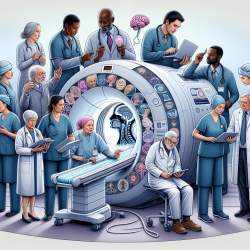Introduction
Alzheimer's disease (AD) is a progressive neurodegenerative disorder that primarily affects older adults, leading to significant cognitive decline and dependency. Despite extensive research, there is no cure or disease-modifying therapy available, and the prevalence of AD is expected to rise dramatically. A recent case report, "Treatment of Alzheimer Disease With CT Scans," offers intriguing insights into how CT scans might play a role in managing AD symptoms.
Research Overview
The case report details a remarkable improvement in a patient with advanced AD who underwent a series of CT scans. The patient received five CT scans, each delivering approximately 40 mGy of ionizing radiation over three months. The report suggests that this radiation induced an upregulation of the patient's adaptive protection systems, leading to partial restoration of cognition, memory, speech, movement, and appetite.
Mechanism of Action
The proposed mechanism involves low-dose ionizing radiation stimulating the body's natural protective systems. This stimulation appears to enhance the repair and removal of cellular damage, potentially reversing some of the cognitive impairments associated with AD. The report highlights that the cumulative dose of radiation was within a range that promotes beneficial health effects without crossing into harmful levels.
Implications for Practitioners
For practitioners, this case report underscores the potential of integrating CT scans into therapeutic strategies for AD. While this is an isolated case, it suggests a need for further clinical studies to explore the efficacy and safety of this approach. Practitioners should consider the following steps:
- Stay informed about emerging research on low-dose radiation therapies and their applications in neurodegenerative diseases.
- Encourage interdisciplinary collaboration to explore innovative treatment modalities that incorporate imaging technologies.
- Advocate for clinical trials to establish standardized protocols for using CT scans in AD treatment.
Encouraging Further Research
While the findings are promising, they also highlight the need for more robust research to validate the therapeutic potential of CT scans in AD. Practitioners are encouraged to engage in or support research efforts that aim to refine and optimize this treatment approach. By doing so, they can contribute to a body of evidence that could transform AD management and improve patient outcomes.
Conclusion
As the prevalence of Alzheimer's disease continues to rise, innovative approaches like the use of CT scans offer hope for improving patient care. Practitioners should remain open to new research findings and consider how such advancements can be integrated into their practice to enhance therapeutic outcomes. To read the original research paper, please follow this link: Treatment of Alzheimer Disease With CT Scans.










